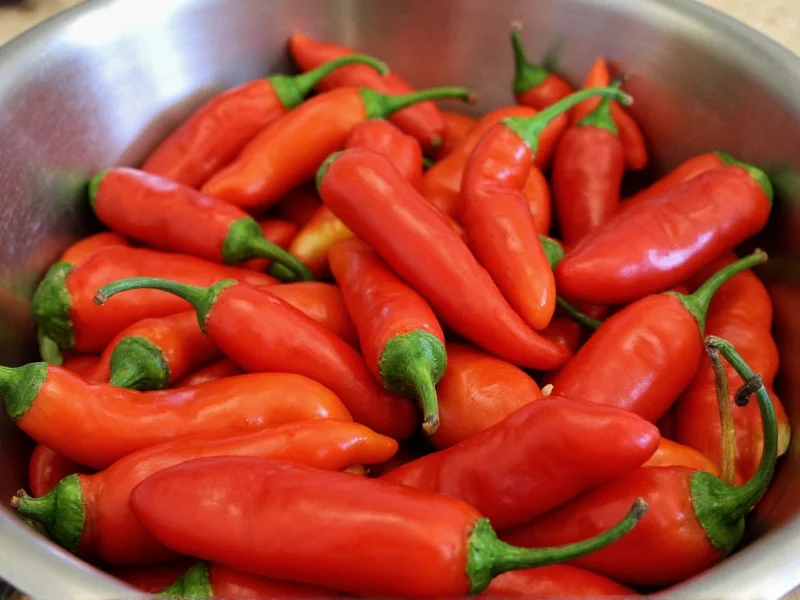When your recipe calls for ajíes dulces peppers and you can't find them, understanding your substitution options ensures your dish maintains the intended flavor profile. Despite the spelling variation in the search query, ajíes dulces refers to sweet peppers in Spanish culinary terminology—mild, non-spicy varieties commonly used across Latin American and Spanish cuisines.
What Are Ajíes Dulces Peppers?
Ajíes dulces (pronounced ah-hee-ays dool-thays) are small, thin-walled sweet peppers with a distinctive conical shape. Despite their name containing "ají" (which often indicates spicy peppers), these particular varieties contain no significant capsaicin, making them completely mild. They're frequently used in Puerto Rican, Dominican, and other Caribbean dishes for their bright flavor without heat.
These peppers resemble miniature bell peppers but with a more tapered shape and thinner walls. Their flavor is sweet with subtle citrus notes, making them versatile for both raw and cooked applications. When unavailable, selecting the right substitute depends on your specific recipe requirements and desired flavor outcome.
Top 5 Substitutes for Ajíes Dulces Peppers
1. Bell Peppers (Best All-Purpose Substitute)
Bell peppers provide the closest match for most cooking applications requiring ajíes dulces. Their thick walls hold up well to roasting, stuffing, and sautéing. While larger than authentic ajíes dulces, the flavor profile is remarkably similar—sweet without any heat.
Usage tip: For raw applications like salads or salsas, use equal parts finely diced bell pepper. In cooked dishes, yellow or orange bells offer slightly sweeter notes than green varieties. Reduce cooking time slightly since bell peppers have thicker walls.
2. Pimientos (Best for Sweetness)
Pimientos (or pimientos de Padrón when mild) deliver exceptional sweetness with tender walls that soften beautifully during cooking. These heart-shaped peppers work particularly well in stuffed pepper recipes, sauces, and roasted vegetable medleys.
Usage tip: Use a 1:1 substitution ratio, but note that pimientos cook faster than ajíes dulces due to thinner walls. They're excellent for recipes where you want pronounced sweetness without competing flavors.
3. Cubanelle Peppers (Best Flavor Complexity)
Cubanelle peppers offer a mild heat (250-500 SHU) with notable sweetness, making them ideal when you want subtle complexity without significant spiciness. Their long, tapered shape closely resembles authentic ajíes dulces.
Usage tip: Perfect for frying, stuffing, or adding to stews. Use equal amounts, but remove seeds if you prefer absolutely no heat. Cubanelles work especially well in Italian and Latin American dishes requiring mild pepper flavor.
4. Banana Peppers (Best Tangy Alternative)
Banana peppers provide similar sweetness with a distinctive tangy note. Their curved shape and thin walls make them suitable for many ajíes dulces applications, particularly in pickled preparations or fresh salsas.
Usage tip: Use slightly less than the recipe calls for (about 75% substitution ratio) due to their tangier profile. They're excellent in sandwiches, salads, and as pizza toppings when ajíes dulces aren't available.
5. Shishito Peppers (Best for Charred Dishes)
While shishito peppers occasionally contain mild heat (about 1 in 10 has noticeable spice), they generally offer the delicate texture and subtle sweetness similar to ajíes dulces. Their thin walls char beautifully, making them ideal for grilled or roasted applications.
Usage tip: Use whole for grilling or slice for stir-fries. Since they're typically served blistered, they work best as a visual and textural substitute rather than flavor match in cooked dishes.
| Pepper Variety | Heat Level (SHU) | Flavor Profile | Best Substitution Ratio | Ideal Cooking Methods |
|---|---|---|---|---|
| Bell Peppers | 0 | Sweet, vegetal, mild | 1:1 | Roasting, stuffing, sautéing |
| Pimientos | 0-100 | Very sweet, fruity | 1:1 | Stuffing, sauces, roasting |
| Cubanelle | 250-500 | Sweet with mild heat | 1:1 | Frying, stuffing, stews |
| Banana Peppers | 0-500 | Sweet-tangy | 3:4 | Pickling, salads, sandwiches |
| Shishito Peppers | 0-1,000 (occasional) | Grassy, slightly sweet | 1:1 | Grilling, blistering, stir-frying |
Cooking Considerations for Pepper Substitutions
When replacing ajíes dulces in your recipes, consider these factors to maintain dish integrity:
Recipe-Specific Recommendations
- For sofrito and recaito: Use equal parts bell pepper and onion. The traditional Puerto Rican base benefits from bell peppers' similar texture and neutral sweetness.
- For stuffed peppers: Pimientos or Cubanelles work best due to their shape and ability to hold fillings without becoming mushy.
- For fresh salsas: Finely diced bell peppers provide comparable crunch and sweetness, though you may want to remove some seeds to mimic ajíes dulces' thinner walls.
- For roasted applications: Bell peppers require slightly longer roasting time than ajíes dulces due to thicker walls—adjust accordingly to prevent overcooking.
When Substitutions Fall Short
Some traditional dishes rely specifically on ajíes dulces' unique characteristics. In these cases:
- For authentic Puerto Rican pastelón, consider growing your own ajíes dulces plants if unavailable locally
- In Dominican mangú toppings, bell peppers work acceptably but lack the subtle citrus notes
- For Venezuelan reina pepiada avocado salad, Cubanelles provide the closest flavor match
Finding Authentic Ajíes Dulces Peppers
If substitutes won't suffice for your specific recipe, consider these sourcing options:
- Latin American grocery stores: Typically carry fresh ajíes dulces during summer and fall months
- Farmer's markets: Check vendors specializing in Caribbean or Latin American produce
- Gardening: Seeds are available online (search for "ají dulce seeds")—they grow well in containers
- Preserved options: Look for bottled ajíes dulces in olive oil at specialty stores
Growing your own is often the most reliable solution, as these plants produce abundantly once established. They require similar conditions to bell peppers but with slightly more heat tolerance.











 浙公网安备
33010002000092号
浙公网安备
33010002000092号 浙B2-20120091-4
浙B2-20120091-4